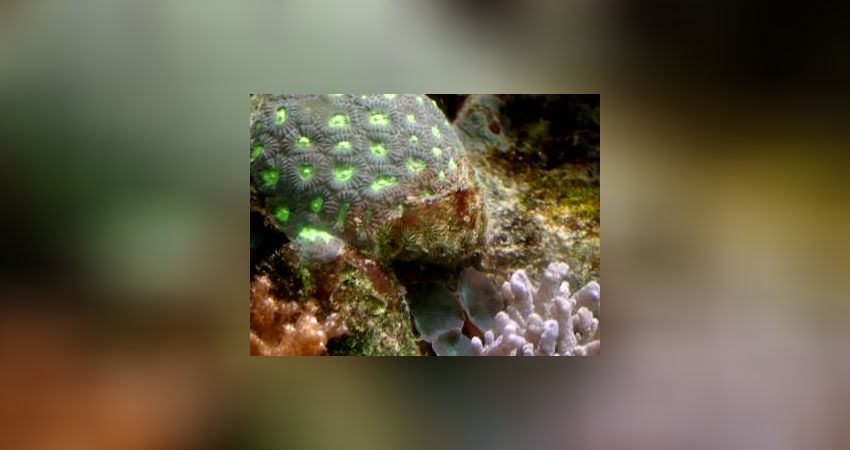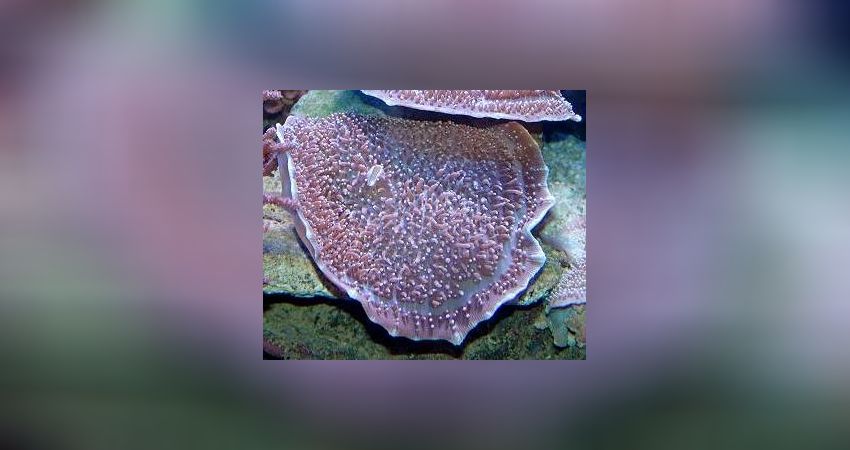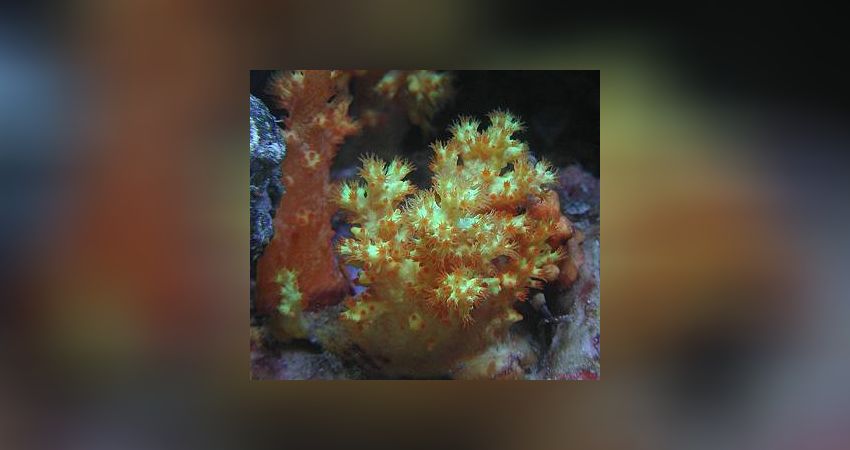23 - Crustose disc anemones and soft corals:

A small overview of often common beginner animals
A small &Uml;berblick über Anfängertiere
Krusten - Scheibenanemonen und Weichkorallen
After the algae phase, the aquarium is now ready for the inclusion of animals and corals. There are many aquarists who would like to keep soft corals, leather corals, crustose anemones as well as disc anemones. For this reason we would like to introduce you to some species that are well suited for aquarium care. They are more forgiving of initial mistakes in the water parameters than delicate stony corals. We will come to the keeping of stony corals, large polyps as well as small polyps, in a later article.
We would like to give you an important hint along the way. Leave enough space between the animals in the aquarium, because they are still growing. It may well be that at some point you will have to take "gardening" action, you will have to intervene. Some corals grow together quite quickly. As every coral, disc anemone and crustose anemone fights for settlement space, entanglement can occur. The nettling is caused by the animals touching each other, partly with some corals - with the fighting tentacles already mentioned elsewhere.
A disc anemone threatens a Montipora and entangles it...

The stronger animal (the more nettled one) will prevail and displace others. Here you should intervene and separate the animals, or if this is not possible, cut back the corals. The newly obtained corals are then offshoots that can be passed on to other aquarists. You can also offer them to the trade, which now frequently offers offshoot corals.
Here several animals are threatening the brain coral, which is already showing the first signs of dissolution. 1. disc anemones green, Sinularia right and left

Sinularia and disc anemones:
We will only briefly discuss these animals. Mostly considered by newcomers and recommended by many authors as particularly suitable starter animals, they can become a problem for the advanced aquarist who wants to keep stony corals. The already mentioned rapid growth, which is often even faster with crustaceans and disc anemones than with other animals, becomes a problem here. They are secondary colonisers that are able to adapt to almost any conditions, including worse ones. In addition, the strong cnidarian power of the animals is able to displace many other corals. Nevertheless, the care is usually very simple and they clearly have their charm.
Who has ever stood up and wanted to remove crusts or disc anemones from a stone knows what the authors mean. It is very difficult to remove these animals from the aquarium, as it is usually not easy to take the stones out of the aquarium.

Palythoa sp, green crustose anemones: Especially crustose anemones from the genus Palythoa can become a problem, as they tend to nettle other animals. In addition, they are highly poisonous - which makes removing them from the substrate somewhat difficult. You should not touch this type of anemone unnecessarily and avoid contact with the mucous membrane or mouth. If one gets dizzy after touching it, it is better to consult a doctor to be on the safe side.
But since they are especially suitable for the first time, we suggest not to integrate such a colony into the stone structure with the other corals, but to establish it a little separately from the other animals. This way you can keep them under control. It is difficult to convey the experiences made in this way, but as a rule almost everyone who keeps stony corals often wants to remove exactly these species from the aquarium, as they take up settlement space.
Discosoma sp. green disc anemones from the aquarium of one of the authors. These were also initially introduced many years ago, and are now a problem in many places. They even threaten a brain coral and are slowly but surely killing it. Therefore, you should think carefully about stocking them, and if so, proceed in a similar way to that described for the crustose anemones. There are many different types of crustose and disc anemones, including particularly beautiful ones. In the trade you will rarely find large disc anemones called elephant ears, as the name suggests. An elephant ear poses a danger to other animals in the aquarium, as it tends to grab and eat especially new animals that come into contact with it.


It is therefore advisable to have a species tank where the animal can be kept separately. It feeds on its zooxanthellae and on food that it catches. We know quite a few aquarists who have also lost large angelfish when keeping the elephant ear. This mention should therefore serve as a warning, so beware!
Fortunately, today it is common practice to breed offspring corals, so that you do not only have to resort to taking them from nature. There are now even so-called coral farms that are operated in Germany and, of course, in neighbouring countries. However, some private aquarainers also offer captive-bred corals, in addition to the specialised trade, of course. Ask in the trade for offspring! The authors would prefer them to imports any time. But not all corals are available in sufficient quantities as offspring.
After some time, when your corals grow, you will be able to give corals to other aquarists yourself. Depending on the type of coral, this can happen faster or slower, but it also often depends on the water values and how comfortable the animals feel. If they have enough space, light and water movement, most of them will usually grow well.
Just have a look at the Meerwasser-Lexikon.de where you will find many animals that are suitable as beginner animals. The species we have summarised only represent a small part of what is possible.
Soft corals and leather corals:
It is almost impossible to present all available species, which is why we have limited ourselves to a small overview.
Sarcophytum - Mushroom leather coral: As you can see in the picture, mushroom leather corals can grow quite large. They are easy to keep, but need a good, preferably alternating current, so that no detritus remains in it. If such a coral initially stays closed and becomes slightly glistening to greenish, don't worry at first. The animal is cleaning itself. It can only peel off the resulting skin if there is enough moisture. Afterwards, the animal will shine again in its old splendour. Especially during removals and long transports, this species stays closed and cleans itself first. Mushroom leather corals tolerate as much light as other species, but should be placed in the bottom as much as possible, as they simply grow too big and then shade too many animals. Can also be propagated by cutting off a stalk, but this is often at the expense of the actual shape, or it takes a long time until it looks the same again. Good starter !


Capnella imbricata, Bäumchenweichkoralle: A really good coral - suitable for beginners - that even reproduces by itself if it feels comfortable. What does self-replicating mean? This coral pumps up a side shoot and separates it from the coral. This falls to the ground nearby and continues to grow on its own, the new coral is "born". This coral needs a lot of light and a medium current, but is often satisfied with less than optimal conditions. Then, however, a "voluntary" increase in numbers is not to be expected. This coral is widespread and often quite cheap to have.
Cladiella sp. (sp. stands for species)
A species that we also find very interesting and which can be easily propagated, as it is also possible to obtain offshoots from it. You cut off a part of the coral with a sharp knife, but better with a scalpel (because it is sharper) and leave it for a few days in a well-drained place. This way the miracle heals much better than in a weakly stranded spot. After a few days the wound has healed and the animal can be established on a stone. This coral should also be treated with caution, as it can entangle others. Can grow to very large populations. Very widespread in the past, but nowadays hardly found in the trade.


Sinularia sp. Bäumchenweichkoralle: Also living on light, this coral is easy to keep and propagate. This coral is also propagated by cutting off an arm. As before, it should get enough light and current.
Xenia sp. pump soft corals: Xenia has always been an interesting coral for many who are starting out in marine aquaristics.Often there are problems when Xenia is first introduced, it is not uncommon for the coral to feel uncomfortable and become smaller and smaller and then die. Often the establishment only works after a few attempts. A little tip: Xenia should always be transported hanging up (on polystyrene), they tolerate this much better than the traditional way in a bag. There are quite a few stony coral fans who would like to have the fast-growing Xenia removed from the tank again, as they can sting and damage other corals on contact. Caution is advised with strong carbon filtration, as Xenia do not like it when all yellow substances are removed from the water, which is often the case with an overdose of carbon. Xenia comes in pumping and non-pumping and in various colour forms, with white/beige being the most common. Once established, it reproduces particularly quickly, but tends to grow upwards towards the light.

All the corals mentioned so far live on their zooxanthellae, i.e. on light. The following species do this only to a limited extent or not at all. This means that they actively consume food, either gelatinous substances or food particles. These animals should never be bought if they are beginners. In special aquariums, many aquarists are experimenting with various types of food, but long-term success in keeping coloured soft corals of the genus Dendronephtea, and many coloured gorgonians, is still pending. Unfortunately, the trade offers these coloured animals, and even as an experienced aquarist you are tempted to try your luck. Leave it alone, failure is certain in most cases.
Coloured soft corals living on food:
As already mentioned at the beginning, these animals are hard or impossible to keep. Of course they are beautiful and that is why they are often bought. Unfortunately, the trade, at least in part, gives rather questionable information about keeping them. As a beginner, you can be glad if you have found a good specialist dealer who can help you competently. The authors know that some keepers will not like these lines, but we do not want to contribute to the destruction of animals that cannot be kept. It is better to leave it alone, or ask other experienced aquarists for advice beforehand. You will also find competent help in various internet forums. It is always better to ask first than to buy first and then ask... Because then it is usually too late.
Sclereonephtea sp. Soft coral: Like all coloured soft corals they hardly last long because they usually lack the right food. Such animals need little light, but in any case suitable food in large quantities. The authors also assume that yellow substances from the water can serve as food. This species lasts longer than the even more colourful Dendronephtea species, but is also difficult to keep in the long run. And in this context one should not underestimate the water pollution caused by the higher feeding rates. Deteriorating water values due to higher feedings make even more technology and even more frequent water changes necessary.


Dendronephtea sp: It is even worse with this coral, which also occurs in different colours. It cannot be preserved in the long term. A special aquarium, laminar flow, little to no light and plenty of food suitable for polyps would be a small approach, but no one can keep it growing or in the long term! Therefore our urgent request not to buy these animals! At least not until a resourceful aquarist publishes instructions for their care, which we do not really expect in the near future. Experiments have been going on for years in many places, but so far they have not promised any resounding success. To date, the authors are not aware of any long-term successes with these truly magnificent soft corals. They are beautiful but unfortunately still only a dream of almost every aquarist. We hope that you will heed our advice and not buy these corals. The more aquarists buy them, the more they will be imported and the more they will die
Frank Diehl and Robert Baur-Kruppas
How do you like this article?
Info
Author

Bookmark
Comments
Topics
Similar articles
- How a marine aquarium is created Part 42: Our solution for a power failure
- How a marine aquarium is created Part 30: Fish, corals, night shots
- How a seawater aquarium is created Part 11: the skimmer is installed
- How a marine aquarium is created Part 45: The new Maxspect MJ-GF4k cross-flow pump
- How a marine aquarium is created Part 28: When space in the aquarium is at a premium.
- 28 - The repositioning of fish
- How a marine aquarium is created-Part 18: Supply KH, calcium and magnesium
- How a marine aquarium is created Part 50: What are the costs of a 400 litre marine aquarium?
- 23 - Crustose disc anemones and soft corals:
- 18 - Ozone
Comments To the top
Anemonen werden zu groß,Weichkorallen vernesseln ihre Nachbarn und die bunten, von Futter lebenden Korallen, kauft man besser nicht ,da man sie unweigerlich zu Tode quält.Ich bin jetzt genau so schlau wie vorher :(
Zumal,je mehr Bücher man wälzt und im Internet liest,desto verwirrter ist man,da sich die meisten Aussagen wiedersprechen!
na ja ich denke dass die Frage was gut und was weniger gut gehalten werden kann, mitunter schon in dem Artikel auch genannt wird.
Zunächst einmal kommt es auf die Beckengröße an. Dann kann man entscheiden welche Art Anemone man darin halten kann. Es gibt auch einige wenig Platz beanspruchende Arten die auch nicht so heikel sind. Und mit dem möglichen Wandern von Anemonen hat man ja auch in größeren Becken zu tun, das ist leider nicht ganz abzustellen. Nicht nur Weichkorallen vernesseln ihre Nachbarn, das tun letztlich auch Steinkorallen etc. Jede Koralle wird um Ihren Plazt und demnach Sieglungsraum "kämpfen" und versucht sich durchzusetzen. Hier ist es an uns, dem Pfleger letztlich soviel Platz zu lassen dass dies nicht passiert oder dann wenn es doch zu nah wird, einfach einzugreifen. Gerde Weichkorallen kann man gut durch abschneiden von Teilen vermehren und insofern auch Platz schaffen. Der Rest wird durch Auswahl an schnell- oder langsam-wüchsigen Korallen natürlich vom Pfleger mit beeinflusst.
Manch bunte Weichkorallen gehören entweder in ein spezielles Filtriererbecken wo man viel mehr Futter anbieten muss, oder man muss einfach auf die Pflege verzichten. Ich meine wenn man schon weiß dass ein Tier nur ganz schwer zu erhalten ist, dann sollte man sich da erst dann dran trauen wenn man weiß was man tut.
Ich bin der Ansicht dass es immer noch genügend Tiere gibt, egal ob Korallen, Wirbellose oder kleine Fische, die man in kleineren Becken gut halten kann.
Ein passende Liste dazu habe ich nicht, wobei ich schon finde dass wir durch die Artikel im 1+1 der Meerwasseraquaristik viele Arten nennen die gut gehen und gleichzeitig auf die eher problematischen Arten hinweisen. Man kann auch mit etwas Erfahrung und dem richtigen Licht bei vernünftigen Wasserwerten auch gut SPS Korallen pflegen.
viele Grüße
Robert
Bunte
Please register
In order to be able to write something yourself, you must register in advance.











